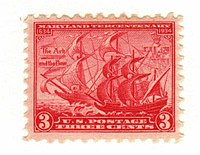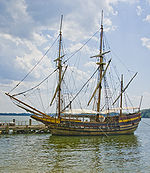The Ark (ship)
 The Ark and the Dove, on a 1934 U.S. commemorative postage stamp.
| |
| History | |
|---|---|
| Name | The Ark |
| Owner | Hired by Cecilius Calvert, second Baron or Lord Baltimore , (1605–1675) |
| Launched | c. 1630 |
| Fate | Lost 1635 |
| General characteristics | |
| Tons burthen | 400 |
| Length | Approximately 132 feet (40 m) on deck[1] |
| Beam | 32 feet (9.8 m) |
| Draft | 14–15 feet (4.3–4.6 m) |
| Depth of hold | 14 feet (4.3 m) |
| Propulsion | Sail |
| Sail plan | Three masted, Spritsail& spritsail topsail, fore course, fore topsail & fore topgallant, main course, main topsail and main topgallant, Lateen mizzen with square topsail. |
| Complement | Approximately 40 seamen |
| Armament | Unknown, but probably capable of mounting 20-25 cannon. |

The Ark was a 400-ton English merchant ship hired in 1633 by Cecil Calvert, 2nd Baron Baltimore to bring roughly 140 English colonists and their equipment and supplies to the new colony and Province of Maryland, one of the original Thirteen Colonies of British North America on the Atlantic Ocean eastern seaboard. On the historic trans-oceanic voyage from England in late 1633 and early 1634, The Ark was accompanied by the smaller 40-ton pinnace Dove.[citation needed]
Maryland expedition
On 22 November 1633, after several delays, two ships, the Ark and Dove, sailed from the Isle of Wight off the south coast of England. Three days later a storm in the English Channel separated the Ark from Dove. When Dove disappeared from view, she was flying distress lanterns, and those aboard the Ark assumed she had sunk in the storm. A second more violent storm hit the Ark on 29 November 1633 and lasted three days, finally subsiding on 1 December. In the midst of the storm, the mainsail was split in half and the crew was forced to tie down the tiller and whipstaff so the ship lay ahull, keeping her bow to the wind and waves as she drifted. This was the last bad weather the Ark encountered on the trans-Atlantic voyage.[citation needed]
On 25 December 1633, wine was passed out to celebrate
On 24 January 1633/34, the ships departed Barbados. An earlier departure was intended but was delayed because
After a week's stay, the Calvert colonists then sailed northward up the large expanse of the Bay, landing on
Although too small for the intended settlement, St. Clement's provided a relatively secure base from which
In the early summer of 1634, the Ark returned to England. The Dove, which had been also purchased by Calvert and the gentry investors in the new colony, remained for the settlers' use in and around the Bay and coasts of Maryland.[citation needed]
In August 1635, the Dove sailed for England carrying timber and beaver pelts, but she never arrived home and was presumed lost in a storm. Maryland Dove is a modern replica of the vessel.[citation needed]
Passengers and Crew for the Founding of Maryland
Passengers aboard the Ark:[4]
Anne, servant of Jerome Hawley
Thomas Allen (d. 1648)
John Altham, J.S.
William Andrews, gentleman
John Ashmore
William Ashmore
James Barefoote, gentleman (d. 1633 en route)
John Baxter, Esq.
Ralph Bean
Thomas Beckwith, servant of Thomas Cornwaleys
Anon Benham, servant of Thomas Greene
Henry Bishop
John Boles, secretary of Cecil Calvert, 2nd Lord Baltimore
Richard Bradley
John Briant
William Browne
Matthew Burrows
George Calvert, Esq. (1613-1634), third son of Lord Baltimore
Leonard Calvert, Esq. (1606-1647), second son of Lord Baltimore, 1st governor of Maryland, and investor.
Christopher Carnell
Thomas Carrington
Richard Cole
John Cook
Thomas Cooper
Capt. Thomas Cornwaleys, Esq., of Turnham Thorpe, Norfolk (c.1605-1676), Commissioner and investor
Ann Cox (d.1638)
Edward Cranfield
Thomas Dorrell, Esq.
Peter Draper, secretary of Leonard Calvert
Richard Duke
Robert Edwards
William Edwin
John Elbin
Nicholas Fairfax, Esq., of Sand Hutton Grange, Yorkshire (c.1606-1633 died en route), investor
Cuthbert Fenwick, Esq.
William Fitter, gentleman
Francisco, servant of Fr. Andrew White
Lewis Fremond
Richard Gerard, Esq., of Ince, Lancashire (c.1613-1686), investor
Thomas Gervase (d. 1637)
Richard Gilbert
Stephen Gore
Thomas Greene, Esq., of Bobbing, Kent (1609–1651), investor and 2nd governor of Maryland[5]
Thomas Griston
John Halfhead (c.1605-1676)
John Hallows, gentleman (d. 1657)
Nicholas Harvey, gentleman (d. 1647)
Jerome Hawley, Esq., of St. Martin-in-the-Fields, Middlesex (1590-1638), investor and co-author of A Relation of Maryland (1635)
Thomas Heath
John Hill, gentleman
John Hilles
John Hillard
Richard Hills
James Hockley
Benjamin Hodges, servant of John Saunders
John Holderen, servant of Thomas Cornwaleys
Henry James
Mary Jennings, servant of Fr. Andrew White
Josiah, servant of Thomas Cornwaleys
John Knowles
William Lewis (d. 1655)
Richard Loe, servant of Thomas Cornwaleys
Richard Lusthead
John Marlburgh
Christopher Martin
Charles Middleton
Roger Morgan
Thomas Munns
John Neville
Richard Nevitt, ward of John Saunders
John Norton, the elder
John Norton, the younger
Robert Pike
Black John Price
White John Price
Lodwick Price
Francis Rabnett, gentleman
John Robinson
Francis Rogers
William Sayre, Esq.
Stephen Salmon, servant of Thomas Cornwaleys
John Saunders, Esq. (d. 1634), co-owner of the Dove and investor
Robert Sherley, servant of Fr. Andrew White
Robert Simpson
Robert Smith
Thomas Smith
William Smith
Matthias Sousa
Thomas Stratham
James Thornton
Cyprian Thorowgood, gentleman
Robert Vaughan, gentleman
Roger Walter
John Ward
Evans Watkins, servant of Leonard Calvert
John Wells
Edward Wintour, gentleman, of Lydney, Gloucestershire, investor
Frederick Wintour, Esq., of Lydney, Gloucestershire, investor
Henry Wiseman, Esq. (d.c. 1634), investor
Crew aboard the Ark
Capt. Robert Wintour, Esq., of Lydney, Gloucestershire, Commander of the Ark
Capt. Richard Lowe, Master of the Ark, of Ratcliffe, Middlesex (d. 1638)
Capt. William Humber
John Bowlter, purser
Richard Edwards, chirurgeon
Crew aboard the Dove
Capt. John Curie, Master of the Dove (d. en route)
Capt. Richard Orchard, Master of the Dove, of Wapping, Middlesex (b.c. 1601)
Nicholas Perry, quartermaster, of Isle of Wight (b.c. 1610)
John Games, gunner, of Ratcliffe, Middlesex (b.c. 1602)
Richard Kempton, boatswain, of Tower Wharf, London (b.c. 1612)
Samuel Lawson, mate
Mr. Warrelow, mate
Michael Perril, servant to the Master
See also
References
- ^ Ship characteristics derived from plans drawn using 17th Century techniques.
- ^ "old Style" and "New Style" dates, hence the practice of writing dates from 1 January to 25 March as 1633/34. The chronology given here is derived from Father Andrew White's diary account of the voyage using the Barbara Lawatsch-Boomgaarden's translation: White, Father Andrew, Lawatsch-Boomgaarden Barbara, trans. "Voyage to Maryland", Wauconda, Bolchazy-Carducci Publishers, 1995.
- ^ Sparks, Jared (1846). The Library of American Biography: George Calvert, the first Lord Baltimore. Boston: Charles C. Little and James Brown. pp. 16-.
Leonard Calvert.
- ^ "Adventurer List". The Society of the Ark and the Dove.
- ^ "Leonard Calvert MSA SC 3520-198". Maryland State Archives. 7 March 2003.
Bibliography
- Browne, William Hand (1890). George Calvert and Cecilius Calvert: Barons Baltimore of Baltimore. New York: Dodd, Mead, and Company.
- Chapelle, Suzanne Ellery Greene, Maryland: A History of Its People Retrieved 6 August 2010
- Russell, Donna Valley and George Ely, The Ark and the Dove Adventurers Retrieved 6 August 2010
External links
- Maryland Dove facts page Retrieved 23 February 2011
- showing a photo of the Dove Retrieved 23 February 2011
- The Dove at riverexplorer.com Retrieved 4 August 2010
- The Ark at www.seakayak.ws Retrieved 6 August 2010
